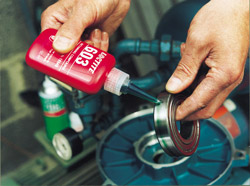
Posted to News on 12th Feb 2014, 12:34
Why use a retaining compound?
When engineering adhesives are employed in cylindrical assemblies, to bond one part inserted into another, they are known as retaining compounds or retainers. They are commonly used for installing bearings in housings or onto shafts, fixing gears and pulleys onto shafts, retaining cylinder liners, sealing engine and boiler core plugs, fixing oil filler tubes in castings and restoring the accuracy to worn machine tools. In many instances secondary machining operations can be avoided and a more reliable assembly is achieved.

These adhesives, whose proven track record extends back to the 1960s, achieve maximum load transmission capability and a more uniform stress distribution. They also eliminate fretting that leads to corrosion, accelerated wear and potential failure.
Where, for example, a bearing is secured by a press fit, the actual metal-to-metal contact accounts for as little as 30 per cent of the total surface of the joint. Small micro-movements at the joint interface can produce particles which abrade and reduce the contact surface even more.
Bearings are also likely to spin either on their shafts or within housings, action that inevitably results in damage, regardless of the type of fit employed. Adhesives can help to eliminate bearing spinout, preventing component damage by filling all surface irregularities. This way movement is prevented, completely eliminating fretting, while creating a fully sealed joint.
Beyond that, tests have shown that the axial strength of an interference fit component can be increased threefold by introducing an adhesive to the joint. Applied as a liquid, the adhesive creates total contact between mating metal surfaces, negating the need for expensive replacement parts and time-consuming machining.
The adhesive can be used on its own or in combination with mechanical methods. They effectively fill the inner space between components and cure to form a strong, high-precision assembly that allows higher loads to be transmitted.
Avoiding unnecessary machining
Newark Electric Motors maintains and repairs various kinds of electric motors, gearboxes, pumps, fans, drives and servos and its engineers use Loctite 641 retaining compound for bearing retention and to secure sleeves to end caps. In many cases, without the use of a retaining adhesive, repairs would require machining and sleeving with a heavy interference fit, even when there was just a small amount of wear. By using a retaining compound unnecessary machining is often avoided, so parts are back in service more quickly.
Another example involves a manufacturer of motorised pedestrian operated tugs. In this case Loctite 640 retaining adhesive is used to secure bearings into the housing holding the unit's handle. As the housing is welded to the tug's frame, distortion of the metal is common, requiring it to be die-ground to accept the bearing.
During this process, just enough metal is removed to enable the bearing to be inserted, even if this results in a varying gap size between the surfaces. The retaining adhesive is applied to the outside of the bearing which is then inserted into the housing.
The adhesive is applied to the outside of the bearing and the housing wall, which is then inserted into the housing. Any gaps between the bearing and the housing wall are immediately filled by the adhesive, which readily cures between the metal-to-metal surfaces.
Choosing the right product
Four key factors need to be considered when determining the best retaining adhesive for the job, and the first is the gap size between parts. Typically, low-viscosity products are only suitable for gaps up to 0.15mm. Temperature resistance is the second factor. The majority of Loctite retaining adhesives, for example, withstand temperatures up to 150degC, but some in the range can tolerate up to 230degC.
The shear strength of the product is governed by whether you need a permanent bond or the ability to dissemble the part in the future for maintenance. And finally you need to think about cure speed. Will you need to make adjustments after the part has been assembled? There is a wide range of products from which to choose, including retaining adhesives that are oil tolerant and others that carry no hazard labelling.
For further information about retaining compounds, please go to www.loctite.co.uk.
Want the latest machine building news straight to your inbox? Become a MachineBuilding member for free today >>














